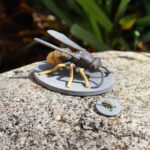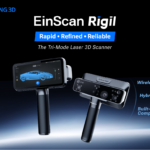The United States Marine Corps, in collaboration with the Naval Air Systems Command’s (NAVAIR), has made a significant advancement by introducing the first Suitable Substitute Engineering Change Proposal (ECP). This initiative addresses ongoing challenges like material shortages and lengthy production delays, marking a pivotal step in improving logistics and part replacement across the fleet.
The AM IPT, established in 2016, focuses on transforming the way parts are produced through 3D printing. For the Marine Corps, this innovation promises faster deployment of essential parts, particularly when time-sensitive replacements are required to maintain operational readiness.

Strategic Role of the AM IPT
The AM IPT, comprised of 20 members, including nine from the Naval Air Warfare Center-Aviation Division’s Modeling and Design Branch, plays a key role in developing more efficient systems for part replacement. Previously, the production of non-critical components faced delays due to the lengthy ECP process. By leveraging additive manufacturing, the team has found a viable solution that allows for the rapid fabrication of smaller quantities of parts, especially those that have become obsolete or are affected by material shortages.
Traditionally, producing these components was a costly and time-consuming process, but the integration of 3D printing has shortened lead times and reduced expenses. This shift is particularly important for the Marine Corps, as it allows for faster responses in cases where equipment or aircraft require immediate part replacements.
Marine Corps Commandant Gen. Eric Smith emphasized the importance of modernizing logistics capabilities: “The myriad unmanned subsurface, surface, and aerial systems that the Joint Force is rapidly procuring are a perfect match for our well decks and flight decks,” he said. Smith also highlighted that amphibious ships are ideally suited to deploy advanced technologies like additive manufacturing and 3D printing, which can significantly enhance the Marine Corps’ operational capabilities.
Selection of the UH-1Y Rescue Hoist Chain Guard Cover
The success of the first Suitable Substitute ECP hinged on selecting the right component for the process. In collaboration with PMA-276, the H-1 Fleet Support Team (FST) and the AM IPT addressed a supply issue related to the UH-1Y helicopter’s rescue hoist chain guard cover. Kevin Tierney, H-1 FST Support Equipment Systems Lead Engineer, explained the extensive work involved in evaluating the part for 3D printing: “We did a lot of work behind the scenes to determine if the guard cover could be reliably 3D printed.”
The team reverse-engineered the original part, developed a CAD model, and conducted test prints to ensure that the 3D-printed version would fit properly. Following this, the AM IPT created a technical data package (TDP) that included the necessary qualifications and certifications for the 3D-printed part. The TDP was then used by the NAVAIR Configuration Management team to develop an abbreviated Class I Suitable Substitute ECP, a process that was completed in just 10 days at a cost of $1,700. In contrast, the traditional ECP process could have cost up to $300,000.
Approval and Fleet Implementation
The final step in the process involved submitting the ECP for approval through NAVAIR’s Enterprise Change Management (ECM) system. Once submitted on August 12, PMA-276 quickly reviewed and approved the ECP and accompanying TDP. Less than two weeks later, the program office received its first implementation letter, officially allowing the 3D-printed hoist chain guard cover to be used by the fleet.
This component, classified as non-critical, was well-suited for the Suitable Substitute ECP process. With approval secured, the H-1 FST began updating maintenance manuals to list the 3D-printed part as an acceptable replacement. Now, if a squadron faces delays in acquiring the original part, they can request the 3D-printed version through their Marine Aviation Logistics Squadron (MALS). Many MALS units already have additive manufacturing capabilities, enabling the part to be delivered in a matter of days.
Historically, replacing this part could take up to a year due to supply shortages. Mike Medlin, H-1 FST Lead Engineer, highlighted the improvement: “Now we can print covers and provide them to the squadron in less than a week.”
Future Outlook for Additive Manufacturing in the USMC
The successful implementation of the Suitable Substitute ECP for the UH-1Y rescue hoist chain guard cover marks a significant achievement for the Marine Corps. With the ability to produce these parts on demand, the Marine Corps expects to manufacture five to seven covers annually. This milestone opens the door for other parts to be produced through 3D printing, reducing dependency on traditional supply chains and enhancing operational flexibility.
“This was a team effort, and it is exciting to have a Get Real Get Better victory for the fleet as we continue to advance AM capability,” said Joe Risalek, PMA-276’s H-1 Sustainment Assistant Program Manager for Systems Engineering. The success of this initiative demonstrates how 3D printing can streamline logistics, reduce costs, and improve readiness across the fleet.
As the Marine Corps continues to explore additive manufacturing, the Suitable Substitute ECP process will play a key role in modernizing logistics, ensuring faster and more efficient support for operations.










